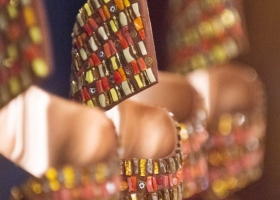
The Best ofIntima & Swim Edit
Vizoo: bringing materials from sample to screen
22 November 2022
In 3D designs, one essential aspect is the quality of the fabric imported into the system. One company stands out in material digitization: the German start up Vizoo. We met with Renate Eder, co-owner.


The digital world has long
been running parallel to, and
often far ahead of, the physical.
From design to sampling,
having a dependable, digitized
version of both materials and
end products is essential to
increasing efficiency, speeding
up production and reducing
waste. Vizoo’s technology aims
to make material digitization
easy and accessible to people
at all stages of the supply
chain. Founded in 2013,
Vizoo already has 300 clients
in more than 40 countries, in industries including
automotive, interiors, gaming and entertainment,
and of course fashion!
Renate, can you please give us a brief outline of
how Vizoo was born?
Myself and fellow Vizoo owner Martin were both
working at Adidas on a project implementing a
scaled creation of 3D samples throughout the apparel
supply chain (from supplier to sales and marketing).
During this work, we saw that a standardized way
of capturing materials is key to a sustainable digital
creation process.
That’s when Vizoo was born: we set out on a mission
to provide the most efficient solution to capturing
and digitizing materials.
What innovative factor makes
Vizoo’s business model stand out
from other existing solutions?
Vizoo xTex was created with the
aim of enabling industrial mass
production of digital fabrics. Our
driving objective is to make the
creation of digital fabric twins
so easy that anyone can do it. At
the same time, we guarantee a
consistent high-quality output.
Having said that, our target
clients are fabric mills and the
users might not have had any
touchpoints with 3D before
operating our tools. For the fabric manager, the
speed of the technology and a fast-learning curve
are key; for the brand receiving the digital fabrics,
the most important factor is quality. Our solution
finds its strength in the satisfaction of all of these
requirements.
Would you say Vizoo is particularly interesting for
bodywear (intimate apparel ad swim ) ?
Absolutely. Our system is designed to be extremely
accurate in capturing transparency as well as structures
such as embroideries. While we already have several
success stories in the lace and intimate apparel area, I
still see much more potential for us in this field. In my
opinion, the lingerie and swim industry is still new to
3D. To date, some of our clients from the lingerie and swim industry include Forster Rohner, Clover Group,
Hämmerle & Vögel, Van de Velde, MAS Intimates,
American Phil Textiles, Delta Bogart, Lee Tai Sang
Swimwear Factory-
Elasticity is a crucial topic in bodywear… how do
you address this issue?
First and foremost, our system covers the visual
aspects of the material. We also have a solution in
place to provide mechanical properties like elasticity.
However, the garment simulation of those fit-relevant
aspects is not covered by our technology. This is where
our material is fed into a third-party 3D simulation
software like Browzwear or Clo3D, where it is applied
onto a pattern. Here, the interaction of the bodywear
with the 3D body avatar can be experienced. There are
promising developments like “soft body avatars” which
will especially cater to the needs of the lingerie area.
How do you see the future of 3d design?
3D Design is becoming more and more established
in the fashion & lingerie industry. The scaling of 3D
processes increases the demand for digital assets.
Therefore, brands are onboarding their fabric mills to
have direct access to digital materials. Digitization will
soon become an inline task for a fabric mill as their
ROI for digital materials is increasing. And it is not
only the fabric design process where many iterations
can be covered digitally. Another example I would
like to mention is material sourcing, where material
selection is already supported by digital twins. For
example, in our cooperation with the functional fabric
fair Performance Days we make digital materials
available for the exhibiting mills. Thanks to this
initiative a vast number of suppliers understand the
importance of digital materials and how to enhance
the customer experience with digital files.
In any case, digital assets will be an integral part of
the brand and supplier conversation. Relying on and
sharing high-quality assets will result in increased
sustainability and speed gains on both sides.
What is the next big challenge Vizoo is working on?
Of course, we are constantly developing our
technology to meet clients’ needs. However, the
current challenge does not lie in technology
enhancements, rather in implementation. Defining
the right workflows and quality standards is the area
in which clients ask for our expertise. Thus, we as
Vizoo are also acting as consultants.
Suppliers like MAS Intimates (Sri Lanka) show
that the topic is not only pushed by brands, but
also from the supplier side. This turns the tables
and puts responsibility on the brand to commit to
sample reductions and faster decision making as
they promised.
In my opinion it is now time to deliver and commit to
the promises the brand make towards suppliers when
it comes to sample savings and speed gains. Let’s start
leveraging the foundation we have built over so many
years by also putting trust in digital swatches.
Copyright 2025. All right reserved - Terms








